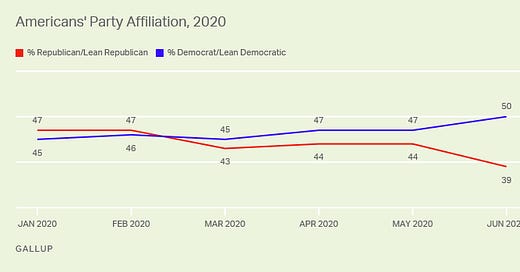It’s really looking like 2008 again
The share of adults aligned with the Republicans has taken a sharp dip this summer
Gallup released new data today showing a sharp decrease in the share of the public that identifies as Republican. As of their June 2020 data, 39% of American adults align themselves with the GOP, whereas a bare majority think of themselves as Democrats. (These totals include people who call themselves independents but actually lean consistently one way toward a particular party.) Gallup’s most recent numbers are a sharp change from their May data, which showed a 47-44 percent advantage for the Democrats.

Let me say right off the bat that I’m skeptical that so large a margin will hold. The long-term trends in these party identification numbers usually move toward a dynamic equilibrium, what analysts call “reversion to the mean.” It’s likely that we’ll see the same thing. Still, it is unlikely that their data next month will show a complete reversal to the spring’s numbers. That’s because party ID is a dynamic, non-stationary process that is best predicted by some average of the recent months of data. That means Gallup’s July data should probably be more like a 6- or 7-point advantage for the Democrats—smack in the middle of their 10-point margin now and their 3-point margin last time.
However, if the new numbers aren’t just a blip, Republicans are in for quite an electoral reckoning. Look at Gallup’s historical trends and you’ll find that the last time the Democrats had this large an advantage in national party ID was 2006-2008. Aside from 2018, those were the Democrats’ best elections of this century. Those years set a deeply ominous tone for the Republicans; back then, an unpopular incumbent party was slammed in the midterms (just like 2018) and went on to lose even worse in the following presidential election. That’s precisely what is shaping up to be the most likely outcome for 2020.

There’s really no other way to spin this than a blaring warning sign for the GOP.
What this could mean for the polls
These data also got me thinking about partisan nonresponse in live-caller phone polls. While it’s true that differential nonresponse is not typically something that occurs over a long stretch of time, this election year is certainly not typical. Between the president’s impeachment, the coronavirus and ensuing economic collapse, the massive protests over the murder of George Floyd and an expanding wave of covid infections now, Republicans have had plenty of reasons to be down on their party—and, perhaps, to refuse pollsters’ calls.
But this is all conjecture. The only point here is: if this is differential partisan non-response, I would expect many polls that don’t adjust for selection to be off. That might explain why polls that condition their samples on joint distributions including political variables (mostly online) have shown a steadier, closer election than the ones that don’t.
And even if the data are being skewed toward Democrats right now, it wouldn’t be enough to explain the whole story. Donald Trump and the Republican Party are in big trouble. We already knew that; these Gallup data are just the latest to remind us.




Why did the Dem ID gap not lead to a blowout win in 2016? I realize it's not as wide as 2008, but it was wider than 2012 and yet even if you look at the popular vote (which admittedly the Dems still won) the margin wasn't nearly as wide in '16 as '12